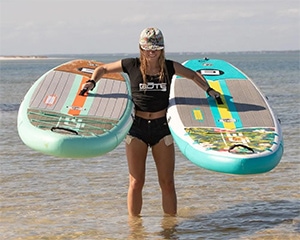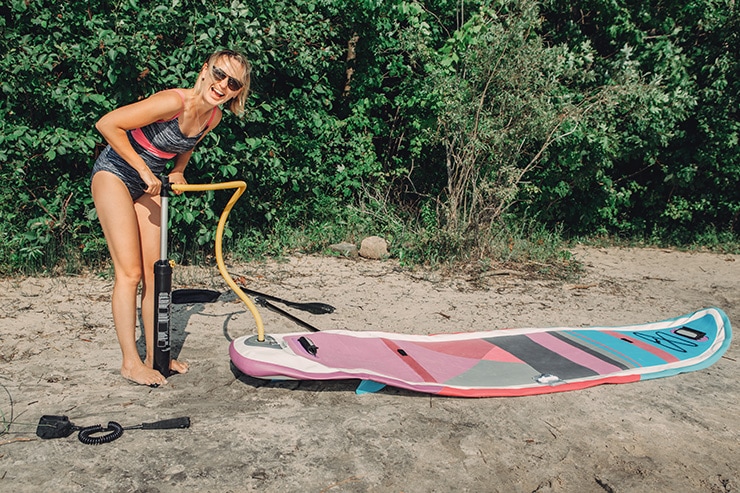Inflatable paddle boards require pressurized air and, because they’re inflatable, it’s natural to wonder if they pop easily. The reality is, inflatable stand up paddle boards are pretty hard to pop and are surprisingly durable. Especially the types of quality inflatable boards available today.
But, just because an inflatable SUP board may be built really well – and will not ‘pop’ during regular use, that doesn’t mean it’s immune to damage. Read on to learn about how an inflatable SUP might become compromised, what happens when it does, and what you can do about it.
Let’s get started!
Is It Easy to Pop an Inflatable SUP?
As already stated, inflatable SUPs will not pop under regular, everyday use. However, it’s important to explore this issue a little more.
Before we get into the details, let’s talk a bit about what it means when an inflatable sup board “pops” as this too can be a bit of a misnomer.
Unlike what you might be imagining, especially if you’re new to paddle boarding, SUPs generally do not “pop” so to speak. Instead, if a paddle board has popped, this usually means it has actually sprung a leak, sustained a tear, or has been damaged in a way that causes it to lose air.
ALSO READ: Do inflatable paddle boards lose air?
Inflatable SUPs are Built to Last

Most inflatable SUPs nowadays are built really well. Inflatable sups are typically made out of a thick sheet piece of flexible military grade PVC that is adhered to some sort of nylon, polyester, or rubber underlying fabric.
Different companies use different types of often military grade materials, and the different combinations also go by different names – depending on which brand you shop.
Deck Padding
Quality built inflatables have a softer deck than rigid ones. The top of an iSUP will be made of a soft deck pad, which serves to both provide comfort (for you) and some protection (for the iSUP).
Additionally, along with this base construction, inflatable boards may also feature an element of tarpaulin for extra durability too.
Drop Stitch Interior

The secret to rigid inflatable boards is the highly pressurized air inside – so wherever you can, opt for an electric pump over a manual pump.
This high pressure is thanks to something called drop stitch technology. This is the use of thousands of tiny fibers inside the SUPs cavity that pull the top portion of the board to the bottom portion.
When highly pressurized air is pumped in, the thousands of fibers keep the board from bulging out of shape. As long as you only inflate to the recommended PSI, you should be left with a rigid stand up paddle board that does not ‘pop’ and feels sturdy on the water.
Will My Dog Pop an Inflatable Paddle Board?
It’s a common question, and understandably so. Will your paddle board pop if you bring your pup along on your paddle boarding trips? Luckily, the answer is probably not.
As iSUPs feature a softer deck with a padded surface, this means it’s typically well protected against your dog’s claws. Chances are, if your pup digs their claws into the board, they are likely to only scratch the surface.
It would be very unusual for a dog to be able to damage an inflatable, but that being said, it’s not a bad idea to ensure that their claws are relatively short and blunt.

How Long Do Inflatable Paddle Boards Last?
Inflatable boards last quite some time, especially if you take really good care of them – and can even hold their own against rigid boards in terms of being able to stand up to bumps and scrapes. A rigid stand up paddle board might not be at risk of puncture, but it can definitely crack!
With proper care, inflatables should be able to last for up to (and sometimes over) five years. This does of course depend upon how often you use them and how you store them.
ALSO READ: Inflatable vs solid paddle boards – what are the pros and cons?
Can I Leave an Inflatable Paddle Board Inflated?

When you’re storing your inflatable stand up paddle board away, you have the option of deflating it entirely or keeping it inflated.
If you keep it inflated, it’s important to keep it somewhere away from the elements. inflatables are susceptible to sun damage when not in use, so it’s important to keep your paddle board stored somewhere out of the sun and free from anything that might puncture it.
If you know you are going to be putting your paddle board away for the season, then you should probably clean and dry it off then deflate it properly. Getting it packed in its storage bag and keeping it away from items that can puncture it will also elongate its lifespan.
Take Proper Care of Your Inflatable SUP
Proper care and maintenance is a big deal when it comes to ensuring the longevity of your board. How you carry it from one location to another, where you paddle with it, and whether or not you drag it around are all ways that will impact its lifespan.
Here are some quick tips:
- Do not store your SUP in direct sunlight: As stated, inflatables do not like to bake in the sun, as it can cause them to weaken, and expand
- Use caution when transporting your board to the water: iSUPs usually come with a large backpack to carry them when they are deflated, so be sure to make use of this wherever you can
- Clean your SUP after use: Washing down your iSUP with water or some dish soap and thoroughly drying before storing away will go a long way toward extending the lifespan of your board
- Do not over inflate your SUP: You should only inflate to the recommended PSI level, if you over inflate your board you put it under unnecessary strain and may weaken it to a point where it becomes damaged and ruptures
What To Do if Your SUP is Leaking Air
So what do you do if your iSUP does pop (in that you spring a leak while out paddling)? Luckily it’s not as terrible as you may think. Every inflatable SUP will come with some sort of repair kit. This kit will allow you to repair even the most disheartening tears. If you suspect that your inflatable SUP is leaking air, follow these steps:
Find the Leak
Start by finding out where the air is leaking from. You can do this several ways, but the easiest is by putting the SUP in shallow water and inspecting it for bubbles.
Wherever you see bubbles coming from, this is an indication that you’re close to the leak. Sometimes the leak can be an obvious tear, such as a split caused by faulty seams, and sometimes it can be a more annoying pin hole leak caused by a small but sharp object.
Repair the Leak
Once you have found the leak, it’s time to begin touching it up. The length and severity of the leak will determine how you need to repair your paddle board.
Sometimes a bit of glue is all you need, but for more severe leaks, you may need to do a full blown patch repair. Always check with your SUP’s manufacturer to see how to best prepare the leak.
Let Your Inflatable SUP Dry Properly
After you have repaired the leak, it’s important to allow your inflatable paddle board to dry for at least 24 hours. With a more severe leak, you may need to wait two or three days. Once you have repaired your inflatable fully, it should be as good as new.
Do Inflatable Paddle Boards Pop: Final Thoughts
It can be scary to think that you invest money into an inflatable board only to have it pop up on you.
The reality is however, today’s inflatable SUPs are incredibly well built and puncture resistant. In fact, many paddlers will tell you that they absolutely love inflatable stand up boards and will opt for one over a hard shell any day.
If you have concerns over whether or not your inflatable SUP will pop on you, rest easy. Inflatable SUPs don’t pop under normal use, so you likely won’t be dealing with a popped inflatable paddle board anytime soon.

